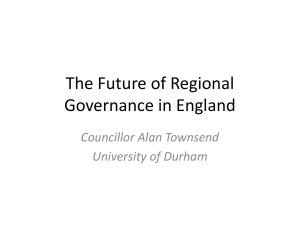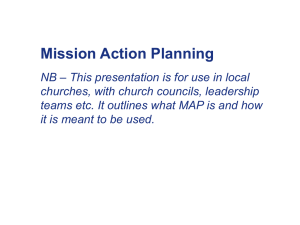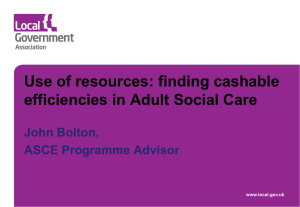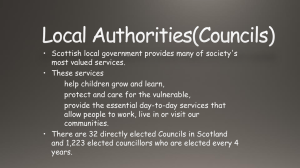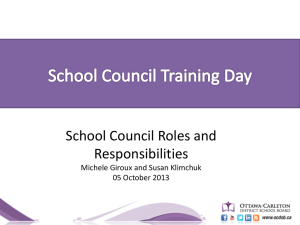Section 1003 (g) of the ESEA
advertisement
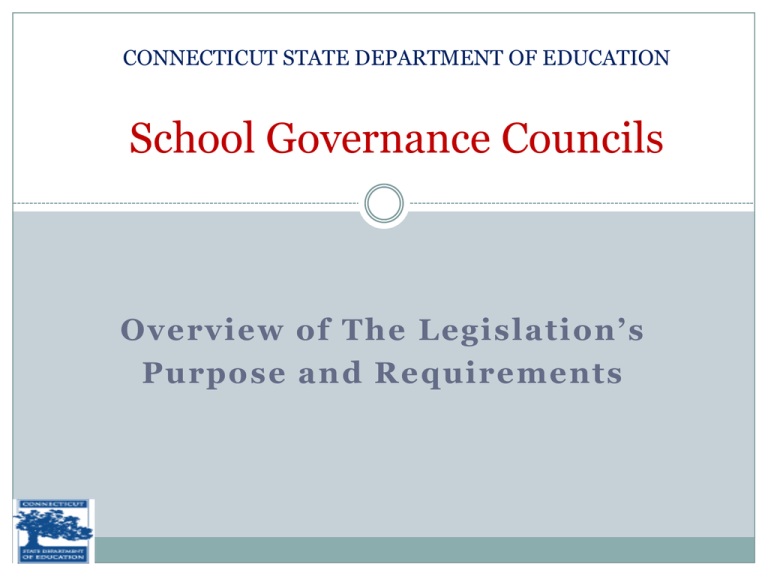
CONNECTICUT STATE DEPARTMENT OF EDUCATION School Governance Councils Overview of The Legislation’s Purpose and Requirements Purpose of School Governance Councils The intent of Councils is to enable parents, school staff, students (where appropriate) and community leaders to work together to improve student achievement in the state’s lowest performing schools. School Governance Councils serve in an advisory capacity to assist the school administration. School-Family-Community Partnerships “Schools, families and communities all contribute to student success, and the best results come when all three work together.” CSBE Position Statement on School-Family-Community Partnerships Guiding Principles Tap the Experts Individuals closest to the students – parents, teachers and community members – have valuable information that can inform decisions about the instructional program of the school. Pull in The Same Direction A school plan to improve student academic achievement receives more support when people understand and help create that plan. Research Supports Partnerships When families participate in a variety of ways in their children’s education, including decision-making, children and the school are more successful. Schools That Must Create Councils By January 15, 2011 By November 1, 2011 Schools that are among the state’s lowest performing 5% Schools that failed to make AYP in math and reading at the whole school level* AND failed to make AYP in math and reading at the whole school level* Exempted Schools: Schools that have only 1 grade level. (Change per Public Act 11-135) * Prior to July 1, 2010 Early Implementation Districts required to establish councils by January 15, 2011 (Bridgeport, Hartford, New Britain, New Haven and Windham), are strongly encouraged to examine the list of schools slated for November 2011 implementation and establish as many councils as possible by the January deadline. Districts that must meet the November 1, 2011 deadline are urged to start a year ahead of schedule by establishing as many councils as possible now. Any school board may voluntarily establish a council for any school this year and may choose to use the model described in the statute or an alternate model. Membership and Selection Process Member Parents or guardians Number 7 Process Elected by the parents or guardians of students attending the school, each household with a student attending the school will have one vote Teachers at the school 5 Elected by the teachers of the school Community leaders within the school district 2 Elected by the parent or guardian members and teacher members of the Council School principal or designee (nonvoting) 1 Principal may name a designee Additional Members in High Schools Student members, high school Councils only (nonvoting) 2 Elected by the school’s student body “Similar” School Governance Council Model Schools may adopt a “similar” School Governance Council model (per Public Act 11-135) For a model to be considered similar to the state mandated model it must meet the following requirements: Duration: The model must have been in place at the time the school was designated as in need of improvement or as a low achieving school. Current Use: The model must have been adopted by the school and currently in use as of July 1, 2011. Membership: The membership must conform to the list of persons/position identified in the law Parents * teachers from each grade level or subject area administrators paraprofessionals * Note: The number of parents should comparable to the state model which requires 7 parents making up 50% of the voting members. Council Responsibilities Councils shall advise the school administration in these areas: Analyze school achievement data and school needs as they relate to the school's improvement plan; Review the fiscal objectives of the school's draft budget and advise the principal before the budget is submitted to the superintendent; Participate in the hiring process of the school principal or other administrators of the school by conducting interviews of candidates and reporting on such interviews to the superintendent and the local board of education; Assist the principal in making programmatic and operational changes to improve the school's achievement; Responsibilities (continued) Develop and approve a written school parent involvement policy that outlines the role of parents and guardians (Note: Schools that receive federal Title 1 funds are required to have a parent involvement policy developed jointly with, approved by, and distributed to parents. A school’s Title 1 parent involvement policy can serve the purpose of the policy required under this section.) Work with school administrators in developing and approving a school-parent compact for parents, legal guardians, and students that outlines the school's goals and academic focus identifying ways that parents and school personnel can build a partnership to improve student learning. (Note: Schools that receive federal Title 1 funds are required to have a schoolparent compact, developed with parents. A school’s Title 1 compact can serve the purpose of the compact required under this section.) In addition to its required responsibilities, a Council may: Assist in developing and reviewing the school improvement plan advise the principal before the report is submitted to the superintendent of schools; Work with the principal to develop, conduct, and report the results of an annual survey of parents, guardians, and teachers on issues related to the school climate and conditions; and Provide advice to the principal on any other major policy matters affecting the school, except on matters relating to collective bargaining agreements between the teachers and the board of education. School Governance Councils Do Not Manage the school; Supervise staff; Enter into contracts or purchase agreements; Discuss individual issues between teachers and students and/or parents; Determine student eligibility for school admission; or Determine class allocations or student assignments. Recommending School Reconstitution After being in place for three years, a Council may vote to recommend that a school be reconstituted using one of the approved models under NCLB or state statute. However, a Council cannot vote to reconstitute a school if it was already reconstituted for another purpose. The statute provides a process whereby the Council’s recommendation for reconstitution must be heard by the local board of education which must accept, modify or reject the proposal. In a case where the Council and the local board of education cannot agree on reconstitution, the Commissioner of Education must decide. The State Board of Education cannot allow more than 25 schools per year to be reconstituted under this law. Possible Reconstitution Models Federal Models: • “Turnaround Model” • “Restart Model” • “Transformation Model” • Any other model developed by Federal law State Models: • “CommPACT School” • “Innovation School” Training for Councils Local boards of education are required to provide appropriate training and instruction to members of School Governance Councils to aid them in executing their duties. CSDE Responsibilities The legislation requires the CSDE to oversee and report periodically – within available appropriations – to the Connecticut General Assembly on matters such as: the number of Councils; the schools that have been reconstituted; the level of parent involvement; and school progress related to student attendance, achievement and discipline. CSDE Guidance and Support CSDE convenes a stakeholder advisory group Community forums and informational sessions have been taking place across the state Guidance on topics such as: conducting the election and nomination processes and implementing effective schoolparent compacts A School Governance Council web page on the agency’s Web site provides updated information and resources www.sde.ct.gov/sde/SGC Contact Judy Carson, Ph.D. Connecticut State Department of Education 25 Industrial Park Road Middletown, CT 06457 judy.carson@ct.gov 860-807-2122
